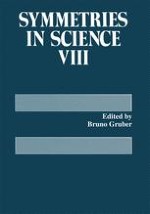1995 | OriginalPaper | Chapter
Recent Developments in the Application of Vector Coherent State Theory
Author : K. T. Hecht
Published in: Symmetries in Science VIII
Publisher: Springer US
Included in: Professional Book Archive
Activate our intelligent search to find suitable subject content or patents.
Select sections of text to find matching patents with Artificial Intelligence. powered by
Select sections of text to find additional relevant content using AI-assisted search. powered by
In the past ten years two types of coherent state constructions have been used to great advantage to give the matrix representations of group generators and the Wigner coefficients of many higher rank symmetry groups. In both, the irreducible representations of a higher rank group are constructed by an induction process from the irreducible representations of a lower rank subgroup, the so-called core subgroup. In the more widely used first type of vector coherent state construction, [1,2,3], state vectors are mapped onto states of a multidimensional harmonic oscillator through a set of Bargmann variables, z, the so-called “collective” or “orbital” variables, and a set of “intrinsic” or “spin” variables, q i , which specify the states of the irreducible representates of the core subgroup, the full state vectors being constructed through a “vector-coupling” of the “intrinsic” and “collective” states. This VCS construction has been used for many of the mathematically natural group chains such as U(n) ⊃ U(n-1) x U(1) ⊃ U(n-2) x U(1) ⊃… for which the subgroup chain gives a complete labelling of the state vectors. The VCS construction leads to SU(n) Wigner coefficients which can be expressed in terms of recoupling (Racah or 9j) coefficients of the U(n-1) sugroup, leading to a very simple buildup process for the construction of the Wigner-Racah calculus for the full group.
